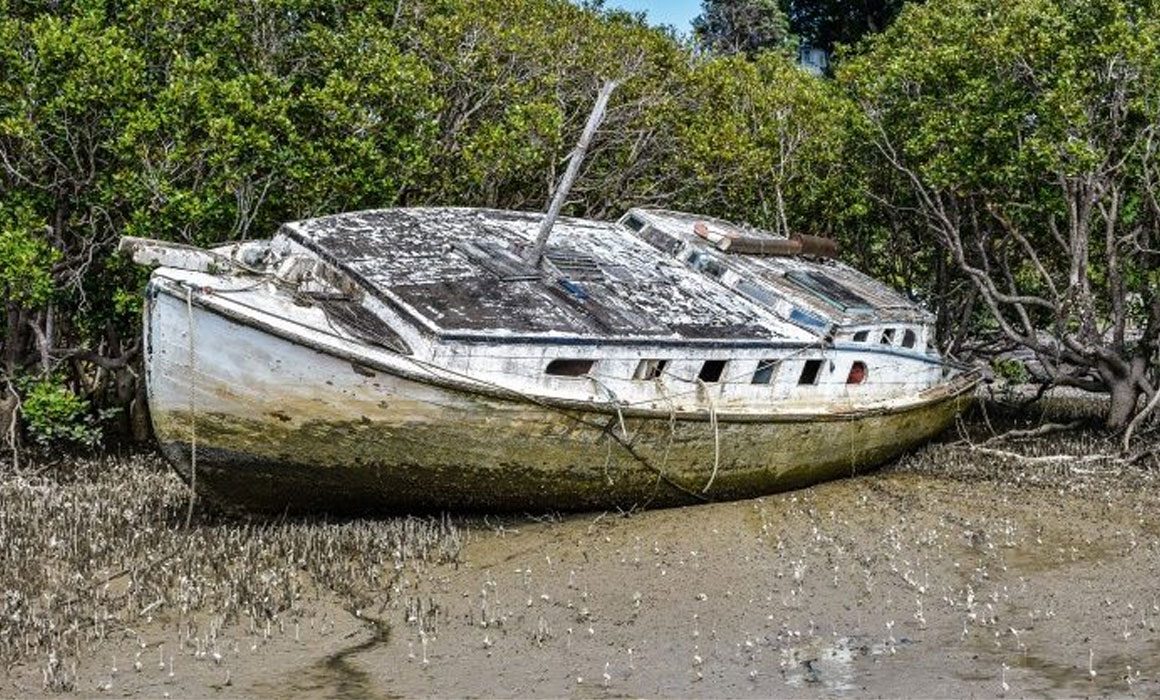

Johnny Wray didn’t want a knighthood or panhandle for sponsorship, but he probably inspired more Kiwis to go sailing than anyone ever has. Waihape, his last boat and the one he owned the longest, is languishing among the mangroves in Hokianga Harbour. Story by Lindsay Wright
In the time it takes to lick an ice cream down to the cone, you can walk from central Rawene, to where a tangle of mud-footed mangroves crowds the beach. Bits of broken boat are strewn on the foreshore but it’s easy to make out the broad transom and art-déco deckhouse of Johnny Wray’s Waihape.
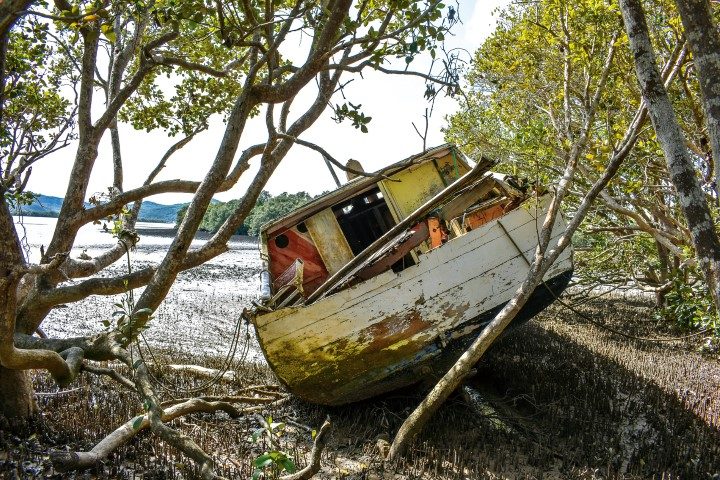
Broken windows and a partly-demolished cockpit have let rain in, but the hull is not irreparably breached and most of the frames seem intact. A 3LW Gardner and Gardner gearbox have deteriorated to a rusty lump amidships and slimy mud coats the bilges, but a nameplate on the deckhouse still carries the derelict’s name.
Most of the planks are full-length kauri and the copper rivets seem tight. It’s a place to spend quiet time – like a decaying shrine to the iconic Kiwi seaman, boatbuilder and voyager.
Waihape, it must be said, was a very different boat from Wray’s legendary first build, Ngataki – the vessel central to his enduring classic – South Sea Vagabonds. And he says as much. Writing in the May 1949 edition of the Australian magazine Seacraft, Wray writes the following about his new boat:
“On 5th December last, I, and about 40 other AuckIand yachtsmen, launched my latest boat, which I, together with the aforementioned 40 other Auckland yachtsmen well and truly christened Waihape (a Maori word meaning ‘to always return’).
“This was, as can well be imagined, a big event in my life, marking the end of a long story of boatbuilding, and also marking, I hope, the beginning of an even longer story of cruising and beachcombing.
“She is a ketch-rigged motor sailer, 44ft by 13ft with a shallow draught of 3’ 6”. The idea was to have a boat small enough to sail single-handed, large enough to go anywhere in comfort, and capable of cruising for at least six months without touching civilisation. Sounds easy enough, but it took a bit of working out.
“An electric refrigerator has a deep freeze compartment that will carry 300lbs of meat at 16oF below zero, so it will last indefinitely.
The fuel tanks total 500 gallons and the fresh water tanks also total 500 gallons, making 1000 gallons altogether. The main engine is a 16hp Lister diesel driving a 24 by 24 propeller through a 2:1 reduction gear.
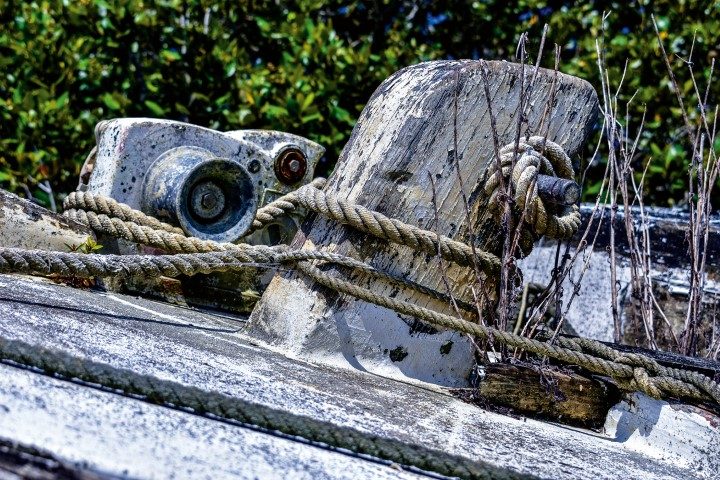
“It is not very powerful, but it is reliable and economical, which is far more important for extended cruising. There is also an 8hp Lister diesel which drives another propeller of the same size through a 3:1 reduction, or a 110-volt 4kW generator. So there is plenty of electricity floating about.
“And there are plenty of gadgets to use it – about 1,000 watts of lights, electric capstan, refrigerator (which hogs the juice), shower pump, bilge pumps, lavatory, exhaust blowers, radio, stove lighters, etc. Both engines are cooled by freshwater in a 20-gallon tank in the engine room, from which the hot water system runs, including a hot shower in a small shower room – a brilliant idea.
“When the cooling water reaches about 180oF it is diverted through cooling pipes under the boat. The Freon 12 liquid of the fridge is also cooled through pipes under the boat, which is more efficient than the air-cooled or heat exchanger units. From the cockpit one goes into the galley, where it could be said that I have spread myself a bit.
“To my mind most galleys are too small considering the time you spend in them. Mine is 14’ by 12’ with 7’ headroom. It sounds far too big, but it is well filled up and the actual floor room is only about 6’ by 8’.
“On the port side there is a steering position (for inclement weather there is also steering by tiller in the cockpit), a small shower room, the fridge and a number of lockers. To starboard there is a plate rack, a 5’ stainIess steel sink bench, three Coleman benzene stoves set in gimbals in stainless steel, and – my pride and joy – a 3’ enamelled wood stove with a healthy-sized oven that is excellent when there is any serious cooking to be done, such as baking bread or roasting.
“There is plenty of driftwood to be picked up and the old stove is seldom out. The main cabin has a large table 5’ 6 by 4’ 6 under which is a 300-gallon water tank. It has seats on three sides and two bunks on the starboard.”
This is all a far cry from Johnny’s earlier vessel, Ngataki, with her driftwood construction, #8 fencing wire fasteners and 44-gallon drum tankage – but when he built Waihape he was 18 years older and just finished a lucrative war time stint as navigator, then in air-sea rescue boats, for the RNZAF.
“The whole set up sounds very complicated and expensive,” he admitted, “for someone who has loosely been described as the uncrowned king of the beachcombers. It is complicated – my homemade switchboard is 6’ high and has 32 switches, five meters and three field rheostats, fuses etc – and gave me a few headaches – but it was not expensive.
“The engines, stoves, tanks and sink were the only things that cost real money. All the gadgets were driven by old, burned-out car generators that I rewound to suit the job. I rewound a dozen car generators – so now I consider myself, among other things, an armature winder.
“You have to be a jack-of-all-trades to build a boat this size singlehanded,” he continued. “Besides being a mere boatbuilder you have to be engineer, sailor, plumber, glass cutter, electrician, painter, rigger, cabinet maker, carpenter….and bull’s wool artist.”
“It would have given me a terrible fright if I had thought of all the things that I would ultimately have to do – I would never have started it. I worked about half part-time and half full-time – 12 hours a day, six days a week,” he wrote. At the same time he also built six dinghies inside Waihape and sold them to help pay for materials.

First off, he built an 18’ launch – Sprat – and reverted to the modus operandi he’d used building Ngataki – salvaging kauri logs off beaches in the Hauraki Gulf, often chugging through a small opening in the anti-submarine boom erected to safeguard Auckland Harbour in wartime, dodging patrol boats and searchlights, bound for the nearest sawmill.
Sprat was painted dark blue for maximum stealth. He remarked that there weren’t as many logs around as there had been when he built Ngataki and he had to go a lot further afield to get enough.
Ngataki was sold to pay for the engines and other fittings but Waihape was built on the cheap too. He had also learned a bit about boat launching. Ngataki fell over twice and survived other mishaps, including almost flooding through the vacant stern gland during launching. Waihape, though, slid smoothly down the ways from a shed on the Wray’s Waiheke Island property and into her natural element.
Waihape was a curious vessel,” author Bruce Ansley says in the foreword to the 2014 edition of Wray’s South Sea Vagabonds. “It took him five years to build – much longer than Ngataki.” Ansley also recorded Wray’s assessment of the boat: ‘all the things I wanted in my dream boat were put in a pot and boiled up – with the result that the finished boat turned out like nothing on earth.’
“She had two short masts to carry sail, and a ‘turtle deck’ with a varnished wheelhouse at the back,” Ansley added. “She may not have been beautiful – but she was seaworthy. She made at least four return trips to Tonga and, with his (Tongan-born] wife, Loti, he cruised up the Great Barrier Reef in Australia.”
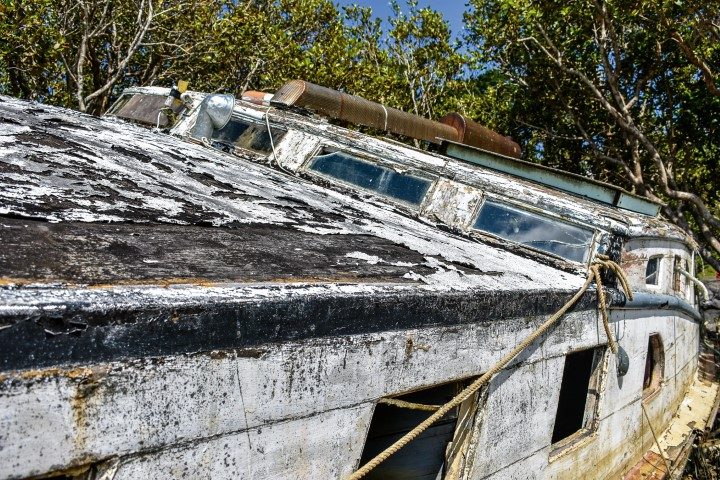
Within a few decades an onslaught of yachting bureaucracy would have kept Waihape tied to the wharf – no lifelines, no stanchions, no EPIRB, flares or SSB, no trysail or plotter – just commonsense and good seamanship.
At home on Waiheke Island, Wray used the boat for fishing, selling his catch from the wharf at Matiatia or anchoring in shallow water off Oneroa so people could wade out to buy dinner.
Eventually old age forced Waihape’s sale and Wray sat on the wharf with his neighbour and soul mate, Harry Sooma, and wept while she sailed for Great Barrier Island with her new owners. Later, a rebuilt Gardner replaced the Listers and, after about 20 years at Great Barrier, she was sailed to the Bay of Islands to begin a refit which never eventuated. Her next voyage was on a truck to a mangrove berth at Rawene.
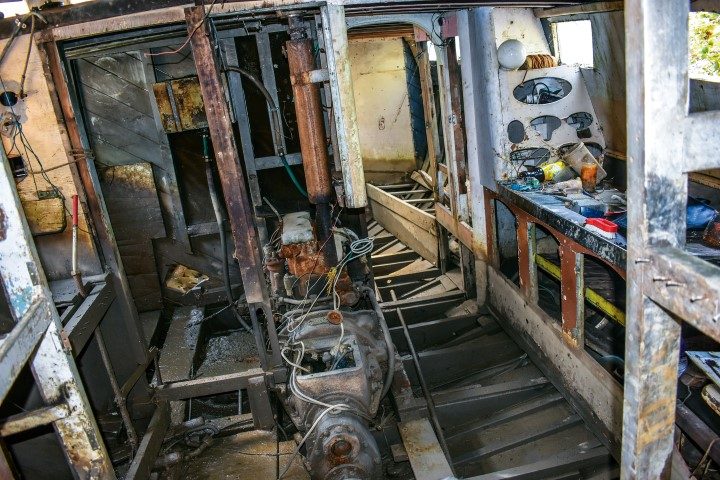
By 1986 Johnny was dead, aged 76, from melanoma and leukemia.
And if he could see Waihape now – he’d still be weeping.
WAIHAPE SPECIFICATIONS
designer & builder J. Wray
construction kauri plank/copper rivets
loa 13.4m
beam 4.0m
draught 1.07m
engines 2 x Lister (CE and Freedom models) and 3LW Gardner
tankage 4500 litres (2250l fuel, 2250l water)
RESCUE
Local men Phil Abbott and Jack Korewhe acquired Waihape and began restoration work but couldn’t find anyone to haul her out and transport her to a builder’s yard in Rawene.
“People went on board and helped themselves to fittings and a solar panel was stolen – then we found she had really bad teredo worm in one of the garboards,” says Phil. “Jack pulled out of the project, then people complained to the harbourmaster about her being there and he threatened to fine me.”

So in March Waihape changed hands again, given to new owners and towed across the harbour to be hauled out of the water and converted into a sleep-out.




